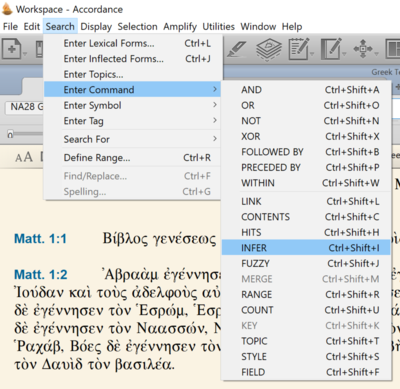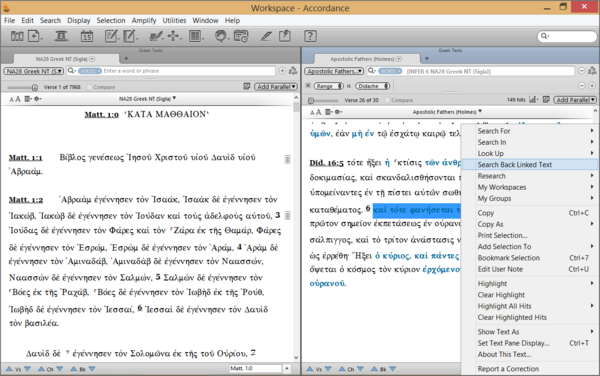 Want to impress your professors? Show them that you know how to do original/independent research using the INFER command in Accordance. Discover intertextuality not only between the books of the Bible, but also between the Bible and related literature of the time period.
Want to impress your professors? Show them that you know how to do original/independent research using the INFER command in Accordance. Discover intertextuality not only between the books of the Bible, but also between the Bible and related literature of the time period.
One of the more challenging tasks a student in biblical studies will face is that of pursuing original research. Easily, we can ask, after 2,000 years of Christian study of the Bible–and even more than that for Jewish study–can anything original truly be found? At one time that question might have been more difficult to answer, but with features like the INFER search in Accordance Bible Software, there continue to be opportunities to make new discoveries.
Let’s start with just the Bible itself. As far back as I can remember, I had access to a Bible with cross references. These references that run parallel with a biblical text indicate where there is a similar theme, quotation, or allusion. This is fairly straightforward and most who have spent any time with any copy of the Scriptures are familiar with cross references. What many do not realize, however, is that most of these kinds of tools were created in a pre-digital age. That means someone had to read through the Bible, and based on his or her knowledge of the entire Bible, wrote down these cross references. Obviously, that is not a perfect system because our brains are not perfect.
Truth be told, though, when we’re discussing the Old and New Testaments, odds are probably against finding allusions or quotations that no one else has seen before. This is where that 2000 years of history works against us. However, the sister of original research is independent research. At the very least, you can use the INFER search to verify not just cross references but also works such as Beale & Carson’s Commentary on the New Testament Use of the Old Testament. In your paper, to show your instructor your independent research—or your original research if you do happen to make a new discovery—you can write something like “Using the INFER search in Accordance Bible Software, I verified…” [or “…I discovered…”].
So what, exactly, does the INFER search do? The INFER search can be used to find allusions or quotations between two independent bodies of literature. This can be done not just between books of the Bible and the testaments of the Bible, but more importantly, between the Bible and extrabiblical literature. As an example of the latter, a couple of years ago at a conference, a doctoral student approached me with a question about how to use Accordance to find any allusions in the extrabiblical Dead Sea Scrolls to a very particular passage in Leviticus about which he was writing. Since we not only have the Hebrew Bible in Accordance, but also the sectarian DSS, I used the INFER search and found multiple passages for him to explore. In recent years, I’ve heard about students and scholars finding these kinds of parallels that had been previously overlooked back in the era when this had to be done simply with the eye and the limits of one’s recall.
I hope I’ve whetted your appetite about using the INFER search. It’s one of the more powerful searches in Accordance, first introduced in Accordance v. 8, but often overlooked by those who don’t know about it. I’m not going to go into detail here about how to use the INFER search since it’s been covered fairly well elsewhere, but I will provide you a few helpful links.
Using the INFER command with Extrabiblical Greek Texts
INFER and SEARCH BACK (Lighting the Lamp Video Podcast #89)
And, of course, don’t forget the Accordance Help System. Really solid instruction for the INFER search can be found in the Help at Biblical Research and Analyses > Search Criteria > Search Commands > [INFER 6 ?]
Final tip for the INFER command: as you follow the steps laid out in the links above, don’t forget the very import SEARCH BACK command as your final step.
Don’t miss previous installments in our Strategies for Students series!
#1 Take Class Notes in Accordance
#2 Use Accordance Editions of Textbooks


